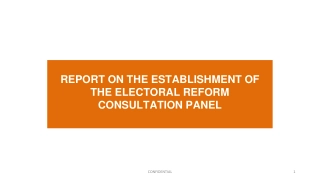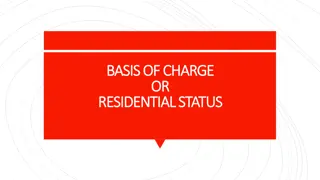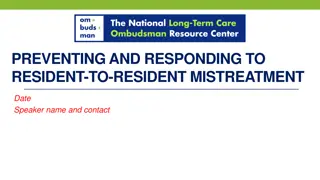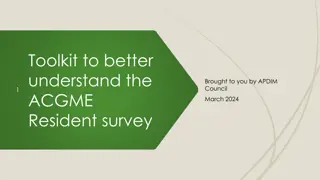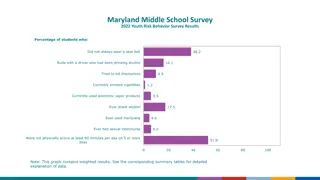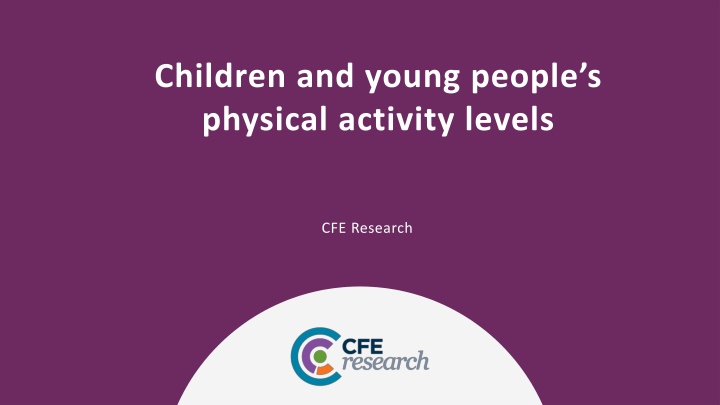
Children and Young People's Physical Activity Levels
Explore the findings from a survey on children and young people's physical activity levels during the third national lockdown. Discover insights on the frequency of physical activity, changes in activity levels, and caregivers' perceptions.
Download Presentation

Please find below an Image/Link to download the presentation.
The content on the website is provided AS IS for your information and personal use only. It may not be sold, licensed, or shared on other websites without obtaining consent from the author. If you encounter any issues during the download, it is possible that the publisher has removed the file from their server.
You are allowed to download the files provided on this website for personal or commercial use, subject to the condition that they are used lawfully. All files are the property of their respective owners.
The content on the website is provided AS IS for your information and personal use only. It may not be sold, licensed, or shared on other websites without obtaining consent from the author.
E N D
Presentation Transcript
Children and young peoples physical activity levels CFE Research
Contents These slides contain the findings from the Residents Panel survey conducted in February 2021. The survey was completed by 79* adults who had caring responsibilities for children who were living in their household (full-time or part-time) or who they provided childcare to on a regular basis. The findings cover: The characteristics of those responding to this survey and the oldest child. Children and young people s physical activity levels during the third national lockdown and the type of physical activities they did. Adult s perceptions about the role of physical activity for children and young people. Anticipated changes in children and young people s physical activity levels in the coming months. * 183 residents in total responded to the survey but 104 were screened out because they did not have any caring responsibilities for an under 18 year old.
Demographic characteristics
Demographics of respondents Age of oldest child Age Number of respondents Income Number of respondents Number of respondents 16-24 5 Low income 45 Under 5s 17 25-44 51 Other income 28 5-11 21 Unknown/prefer not to say 45-64 18 6 12-17 35 65+ 5 Not stated 6 Gender of oldest child In an Active Communities area Gender Number of respondents Number of respondents Number of respondents Male 15 Male 33 Yes 36 Female 64 Female 45 No 43 Not stated 1 Number of under 18s in household Ethnicity Number of respondents Number of respondents White British 65 Only 1 34 BAME 14 More than 1 45
Physical activity levels and type
Children and young peoples physical activity levels during the third national lockdown More than 1 in 10 carers (13%) reported that the oldest child did not typically undertake 30 minutes or more of physical activity on any day throughout the third lockdown. On average, the older the child the less physical activity they undertook. Worryingly, 32% of carers stated the oldest child did more physical activity during the autumn term than during the third lockdown highlighting the impact COVID-19 may have had on activity levels. Days per week the oldest child did 30mins or more of PA PA in the third lockdown versus the autumn term More physical activity in the autumn term 0 days 13% 32% 1 day 9% Same amount of physical activity in the autumn term 39% 2-3 days 28% 4-5 days Less physical activity in the autumn term 24% 23% 6-7 days 24% Don't know 6% Don't know 3% Q4. Thinking about the oldest child or young person that you have caring responsibilities for, during the current national lockdown typically on how many days per week do they do a total of 30 minutes or more of physical activity which is enough to raise their breathing rate? N=79 Q5. Overall, how does the amount of physical activity that the oldest child or young person that you have caring responsibilities for is taking part in now compared to the amount of physical activity they were taking part in during the autumn term (September-December)? N=79
The type of physical activities children and young people did during lockdown 3 Moving about while playing (e.g. at home) 62% The oldest child was most likely to regularly keep active through moving about while playing (62%), walking for fun/leisure (59%), and/or dancing for fun (43%). Walking for fun/leisure 59% Dancing for fun/informally with family 43% Cycling for fun/leisure or sport 30% 6% or carers indicated that the oldest child not participate in any regular type of physical activity. Doing children's fitness/exercises sessions at home 28% Walking for travel 19% - This is slightly less than the 11% of UK parents surveyed by the Youth Sport Trust. Taking part in sport 14% Cycling for travel 5% Other 3% No physical activity 6% Q7. Which of the following physical activities does the oldest child or young person that you have caring responsibilities for regularly take part in during the current national lockdown? N=79
Perceptions about physical activity
Views about children and young peoples perceptions of, and behaviour in relation to, physical activity (PA) The majority of carers recognise the benefits of PA on the oldest child with it having a positive impact on their physical and mental health. 71% believe the oldest child enjoys physical activity/sport but 58% also state they prefer other activities over PA or sport. Only 61% state the child is confident to do PA or sport. Proportion agreeing PA has a positive impact on their physical health (n=74) 5% 4% 5% 16% 69% 85% PA has a positive impact on their mental health (n=72) 6% 14% 17% 61% 78% PA makes them happy (n=76) 7% 16% 25% 50% 75% They enjoy most forms of PA and sport (n=73) 8% 7% 14% 27% 44% 71% They decide whether they want to do PA and sport (n=73) 10% 11% 11% 19% 49% 68% They feel confident to do PA and sport (n=69) 17% 9% 13% 14% 46% 61% They understand PA and sport benefits physical/mental health (n=67) 10% 10% 21% 18% 40% 58% They prefer to do other activities over PA and sport (n=71) 11% 11% 20% 10% 48% 58% COVID-19 increased understanding of PA and sport's importance (n=66) 18% 14% 18% 18% 32% 50% They would be less likely to do PA/sport if their friends didn't (n=64) 23% 8% 20% 22% 27% 48% They only engage in PA/sport at school (n=67) 31% 18% 12% 13% 25% 39% More opportunities to exercise at home encouraged them to do PA (n=67) 30% 24% 10% 18% 18% 36% 0-2 3-4 5 6-7 8-10 Q6. To what extent do you agree or disagree with the following statements about the oldest child or young person that you have caring responsibilities for?
Carers perceptions of, and behaviour in relation to, the oldest child s physical activity (PA) Promisingly, at least 7 in 10 carers recognise the important role they play in influencing children s* physical activity levels, they act on this, and themselves enjoy taking part with them. Proportion agreeing However, nearly 3 in 10 carers do not believe local facilities support their family to be active. It is my responsibility to find physical activity opportunities for my children* (n=79) 86% 5% 6% 25% 61% I actively encourage my children* to take part in physical activity (n=78) 86% 13% 22% 64% I am aware of the need to increase my children's* physical activity whilst they are not participating in school PE (n=75) 12% 17% 68% 85% I enjoy taking part in physical activity with my children* (n=79) 9% 4% 10% 25% 52% 77% I actively encouraged my children* to increase their activity levels during the pandemic to support their physical and mental health (n=76) 13% 11% 24% 50% 74% I feel able to take part in physical activity with my children* (n=78) 9% 10% 12% 21% 49% 69% Local facilities (e.g. parks) support us to be an active family (n=76) 18% 9% 12% 14% 46% 61% COVID-19 provided more opportunities to be an active family (n=77) 27% 12% 12% 16% 34% 49% Physical activity and sport clubs provide necessary childcare (n=70) 31% 6% 20% 16% 27% 43% Physical activity is the only way we can get around (e.g. to travel) (n=77) 45% 9% 18% 10% 17% 27% 0-2 3-4 5 6-7 8-10 * The children I have caring responsibilities for Q8. To what extent do you agree or disagree with the following statements more broadly?
Physical activity intentions and barriers
Carers own intentions, and their child's, about physical activity in next 3 months 3 in 5 carers (63%) would like their child to do more physical activity but this is not necessarily reflected by the child themselves (23%). 63% Do more physical activity 23% - Whilst the gender of the child did not affect the results - male carers (93%) were more likely than female carers (56%) to want the oldest child to do more physical activity. 42% Try new forms of physical activity or sport - Carers of those aged 12-17 year olds (74%) were more likely to state this compared to those aged under 5 (35%). Those who were under 5 on average took part in physical activity lasting 30mins on 5 days compared to 3 days for those aged 12-17. 27% 10% Don't know Only 1 carer would like their child to do less physical activity in the coming 3 months, and only 1 carer thought their child would like to do less physical activity. They would like child to Think child would like to Q9. In the next 3 months how much physical activity would you like the oldest child or young person that you have caring responsibilities for to do? N=79
Drivers of physical activity intentions (in frequency order) Physical and mental health benefits, plus the opportunity to socialise are the principal reasons why carers would like the oldest child to do more physical activity in the near future. Carers believe it is their child s love of physical activity which drives their wish to do more and try new types. Reasons carers would like their child to Perceived reasons child would like to My two girls would like to go back to do the dancing they did before. They do it in the house on zoom but only for 1 hour to 2 hours a week - that is a lot less than what they usually do and also to see their friends. increase levels of physical activity Improve their physical health and fitness They enjoy it Improve their mental health Avoid being bored Return to their pre-COVID-19 levels/activities Make new friends try new forms of physical activity /sport Experience new things They enjoy trying new things [child] has autism so is isolated and has no social contact other than with myself. Find new ways to engage them in physical activity Q10. Reasons why? N=79
Barriers preventing children and young people from being physically active and ways to overcome these Two-fifths (n=33) reported there were no barriers to the oldest child taking part in PA or sport. COVID-19 restrictions were the most frequently cited barrier by carers (n=23), including: - Being limited to their home environment with few opportunities to be physically active outside e.g. only cycling and walking in their local area. Before lockdown she was always out with her friends walking and playing football they motivated each other but now its safer to stay at home. - Not being able to access gyms/sports facilities/sports clubs - Unable to meet up with their friends and being active with them e.g. walking around together, going to the park The principal suggestion for overcoming this issue was the relaxation of COVID-19 restrictions. Other challenges experienced by children and young people noted by a handful of carers included: - Limited information and support for children with disabilities and young people (n=4) - Poor quality or lack of local facilities (n=3) [For my daughter] in a wheelchair [it would help] to be able to find out about wheelchair sports in Doncaster. Medical people don't know of any so maybe more information about things like that. A few carers suggested that more sports clubs and better local facilities (both n=4) would help the oldest child be more physically active. Having safer cleaner areas to walk More safe parks that s are clean and tidy. Q11. Are there any issues or factors that prevent the oldest child or young person that you have caring responsibilities for from being physically active? N=79 Q12. What would help overcome this?
So, what does this mean? Levels of inactivity among children and young people during the third national lockdown appear to be relatively low, but for one-third the amount they did had decreased (compared to the previous four months). Carers indicated that children and young people were most likely to have kept active during the third lockdown by playing, walking, dancing or cycling for fun, and doing physical activity sessions at home. Whilst stay local restrictions continue, more information and ideas for carers to support children and young people to retain their engagement in these activities could be helpful. Levels of recognition amongst carers about the benefits of physical activity on the oldest child s health and wellbeing are high, although the proportions who think their children are similarly aware of the positive impacts are slightly lower. Ensuring children and young people understand the benefits of physical activity on their own physical and mental health may encourage them to take part in more activity. Many carers believe the oldest child enjoys most forms of physical activity or sport; however, many children prefer to do other activities and a significant proportion think they are not confident to do physical activity or sport. The social aspect of physical activity or sport is important for almost half of all children and some only take part at school. Most carers recognise the important role they play in encouraging the oldest child to take part in physical activity and in finding them opportunities to do this, especially whilst they are not participating in school PE. Only two-thirds feel able to take part in physical activity with the oldest child whilst for a small proportion physical activity is the only way they can get around (e.g. through active travel). Many carers reported no barriers to the oldest child taking part in physical activity with lockdown being the most frequently cited barrier by carers to children and young people doing more physical activity. They anticipate that the loosening of restrictions will resolve this. Many carers are eager for their child to do more physical activity and to try new activities, and they believe that their children are also keen to do both, although to a lesser extent. There is therefore interest in the introduction of new activities.



